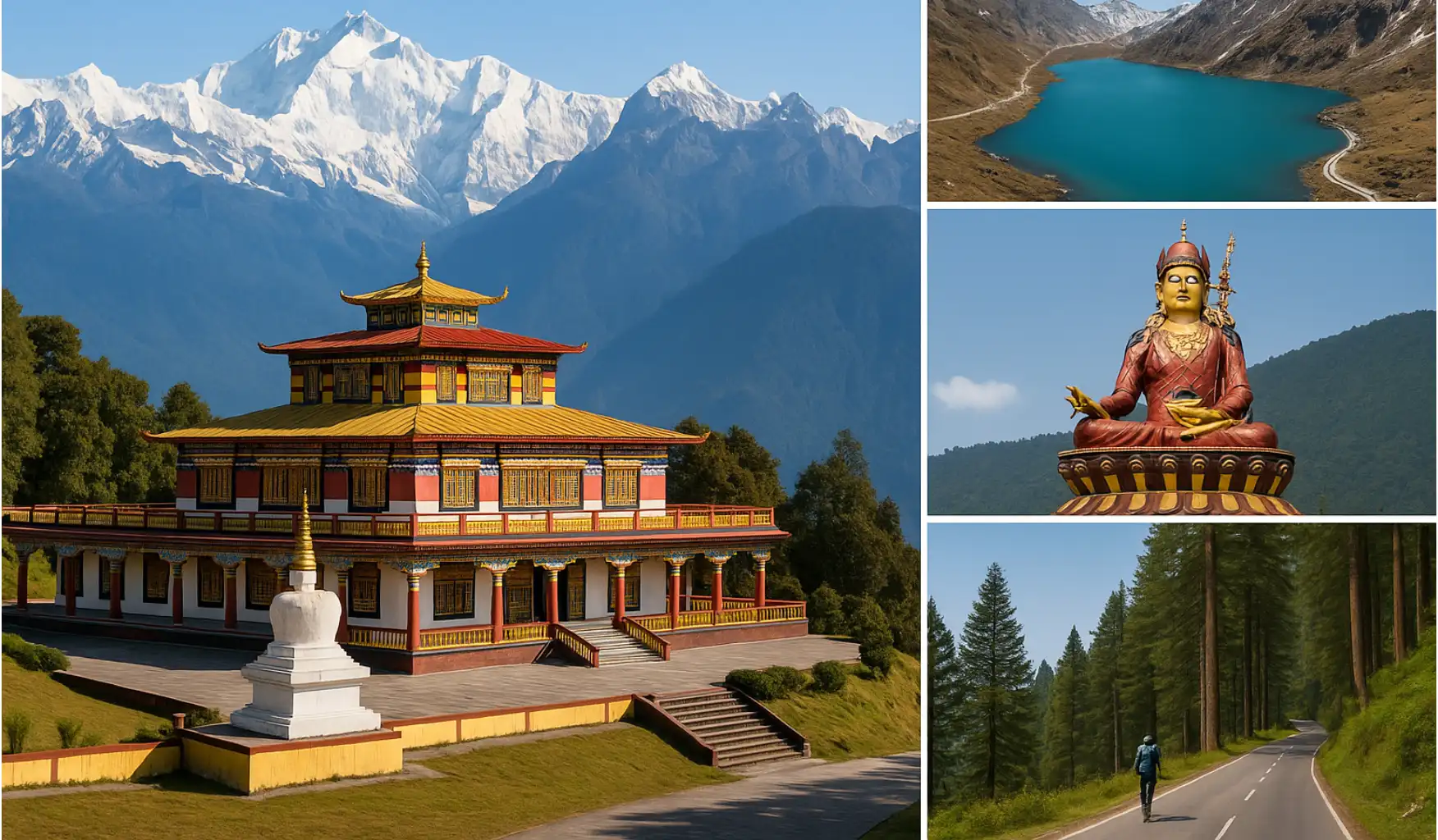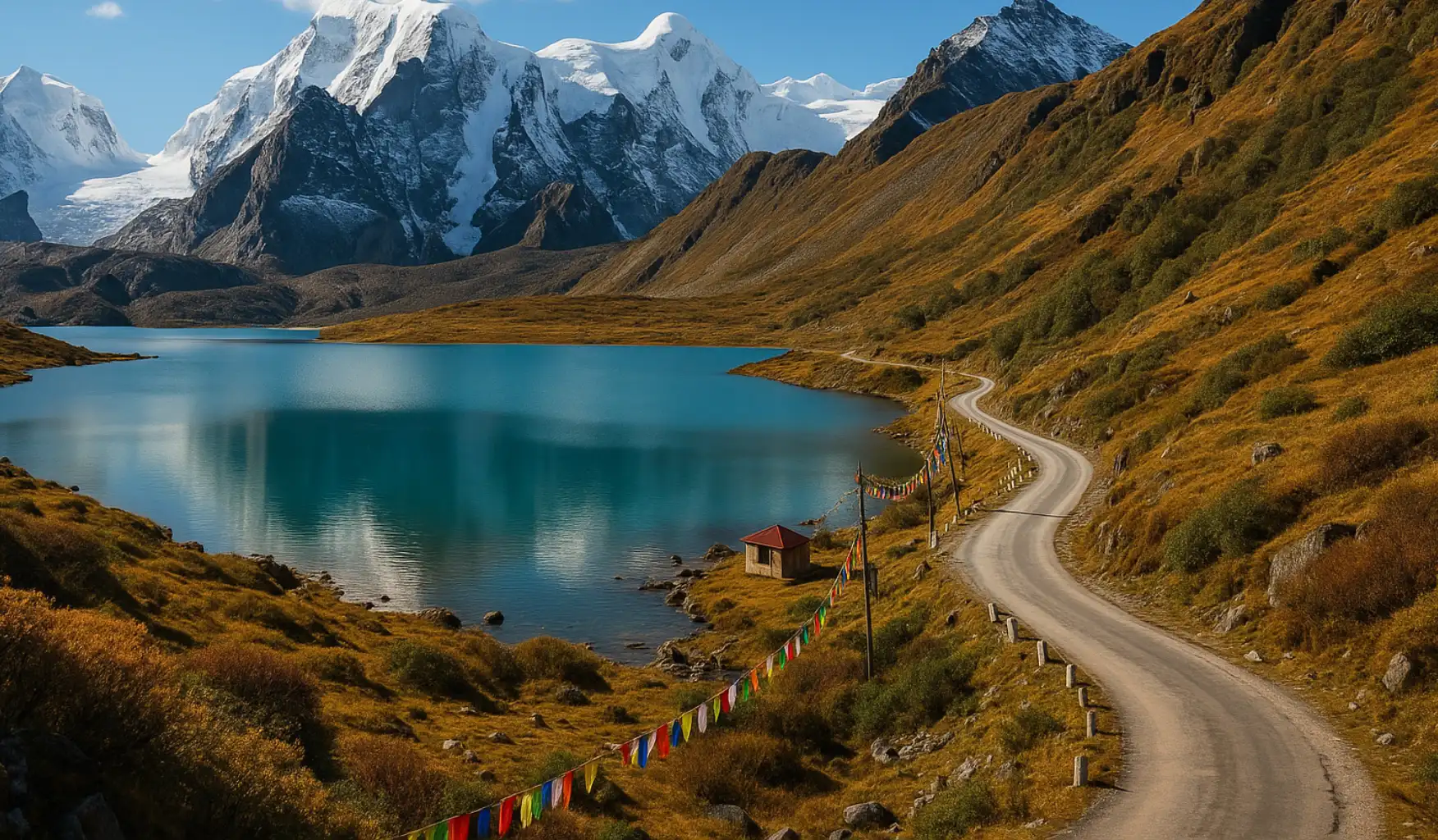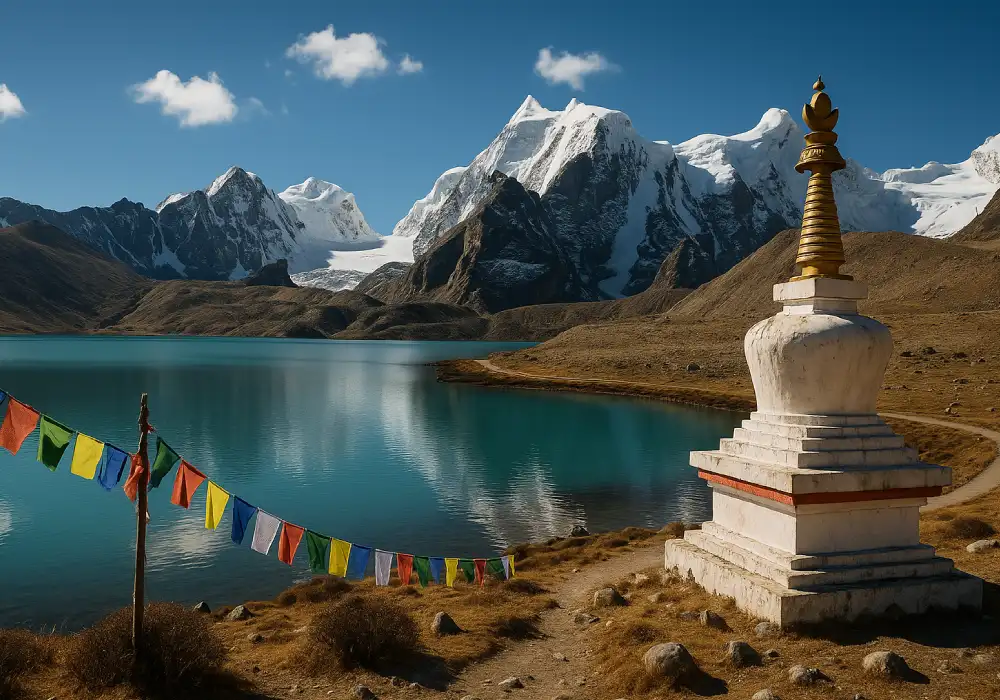Nestled in the lap of the Eastern Himalayas, Sikkim is one of India’s most serene and spectacular travel destinations. From snow-capped peaks and alpine lakes to Buddhist monasteries and vibrant local culture, Sikkim offers a magical blend of natural beauty and spiritual charm that appeals to every kind of traveler.
Whether you’re a solo explorer, a nature enthusiast, or a cultural seeker, Sikkim welcomes you with clean air, scenic drives, and unmatched hospitality. With its eco-friendly tourism practices, organic farms, and peaceful towns, the state has also earned a reputation as one of India’s most sustainable travel destinations.
In this ultimate travel guide to Sikkim, you’ll discover everything you need to know before you go — from the best time to visit, must-see places, and local food, to budget planning, itinerary suggestions, and travel tips to help you plan an unforgettable trip in 2025.
Get ready to explore Sikkim — one of the most soul-refreshing corners of India.

Best Time to Visit Sikkim
With its diverse geography, ranging from 300 to 8,500 meters above sea level, Sikkim offers vastly different experiences across seasons. Whether you’re looking for snow-draped peaks, vibrant flower valleys, or peaceful monastery visits, choosing the right time to travel can significantly shape your journey.
Spring (March to May)
Spring is arguably the best season to visit Sikkim, especially for first-time travelers.
Weather: Crisp and cool, with temperatures ranging from 10°C to 20°C
What to expect: Full bloom of rhododendrons and orchids, clear views of the Himalayas, great trekking conditions
Events: International Flower Festival in Gangtok
Tip: Ideal time to explore Yumthang Valley, Tsomgo Lake, and Ravangla
Summer (June to early July)
Summer is pleasant, especially in the higher altitudes of North and West Sikkim.
Weather: Daytime temps of 15°C–25°C, occasional light rain
What to expect: Lush green landscapes, cool air, good time for family and group travel
Tip: Visit Lachen and Lachung before monsoon sets in
Monsoon (Mid-July to September)
Monsoon brings Sikkim alive with greenery but also comes with travel disruptions.
Weather: Heavy rainfall, misty hills
What to expect: Fewer tourists, off-season discounts, high landslide risk on mountain roads
Tip: Avoid remote hill drives and check weather advisories
Winter (October to February)
Winter is magical, especially for those chasing snow and quietude.
Weather: Sub-zero temperatures in North Sikkim, 5°C–15°C in Gangtok
What to expect: Snowfall in Tsomgo Lake, Lachung, and Gurudongmar Lake, crystal-clear mountain views
Events: Losar Festival (Tibetan New Year), traditional Sikkimese celebrations
Tip: Some areas may require permits or may be closed due to snow—plan accordingly
Recommended Travel Window:
For sightseeing & flowers: March to May
For snow & festivals: October to early February
Osho’s Meditation Resort in Pune is a life-changing location for people looking for spiritual enlightenment in a tranquil, nearly resort-like setting.
How to Reach Sikkim
Despite being a remote Himalayan state, Sikkim is accessible via air, road, and rail—though it requires a bit of planning, especially if you’re heading to North Sikkim or the Indo-China border regions. Here’s how you can reach Sikkim smoothly in 2025:
By Air: Nearest Airports
Pakyong Airport (PYG): Located 31 km from Gangtok, this is Sikkim’s own domestic airport. Limited flights operate from cities like Kolkata, Delhi, and Guwahati. Ideal for travelers seeking direct access.
Bagdogra Airport (IXB): Located in West Bengal, 125 km from Gangtok. It’s the most convenient airport with frequent flights from Delhi, Mumbai, Bangalore, and other metros.
Tip: Prepaid taxis or shared cabs to Gangtok are easily available at the airport exit.
By Train: Nearest Railway Stations
Sikkim doesn’t have its own railway station yet. The closest are:
New Jalpaiguri (NJP): 120 km from Gangtok, connected to all major Indian cities.
Siliguri Junction: 114 km away, often used by travelers coming from North Bengal or the northeast.
From the station, you can take shared jeeps, private taxis, or buses to Gangtok (4–5 hours).
By Road: Scenic Drives
Sikkim is well-connected by road from Siliguri, Darjeeling, Kalimpong, and other nearby towns.
NH10 is the main highway connecting Gangtok to the rest of India.
Sikkim Nationalized Transport (SNT) buses and shared sumos are reliable and budget-friendly options.
Local Transport
Within Sikkim, shared jeeps, private cabs, and bike rentals are common, especially in areas like Gangtok, Pelling, and Ravangla.
For North Sikkim (Lachen, Lachung), you’ll need to book a tour or permit-based vehicle.
The Art of Living Center offers both short-term and advanced programs for spiritual seekers looking to deepen their practices in a peaceful, nature-filled setting.
Top Places to Visit in Sikkim
From snow-laden peaks and sacred lakes to vibrant monasteries and flower-filled valleys, Sikkim’s landscape is a mix of nature, spirituality, and adventure. Whether you’re looking for peace or thrill, these are the must-visit places in Sikkim that should be on your 2025 itinerary:

1. Gangtok – The Capital City
Why visit: Modern meets tradition here. Gangtok is the cultural, commercial, and touristic hub of Sikkim.
Highlights: MG Marg, Enchey Monastery, Tashi View Point, Namgyal Institute of Tibetology, Ropeway rides
Tip: Spend at least 2 days here to get permits for North Sikkim and explore nearby spots.
2. Tsomgo Lake (Changu Lake)
Distance: ~40 km from Gangtok
Why visit: A glacial lake at 12,000 ft surrounded by snow, yaks, and mysticism.
Best time: April to May & November to February (for snow)
Permit Required: Yes (for Indian nationals only)
3. Nathula Pass
Altitude: 14,140 ft
Why visit: Historic Indo-China border pass on the ancient Silk Route. Offers snow-covered landscapes and patriotic vibes.
Permit Required: Yes (closed Mondays & Tuesdays)
Note: Foreigners are not allowed here.
4. Lachen and Gurudongmar Lake
Location: North Sikkim
Why visit: Gurudongmar is one of the highest lakes in the world (17,800 ft) and a spiritual site for Buddhists and Sikhs.
Tip: Spend a night in Lachen to acclimatize before heading to the lake.
5. Lachung and Yumthang Valley
Known as: “Valley of Flowers of the East”
Why visit: Rhododendron blooms (March–May), snowfields (Nov–Feb), hot springs, and surreal scenery
Also visit: Zero Point (last civilian road before the Indo-China border)
6. Pelling – Peaceful Hill Town
Highlights: Skywalk, Pemayangtse Monastery, Rabdentse Ruins, Khecheopalri Lake
Why visit: A less-crowded alternative to Gangtok with stunning Kanchenjunga views
7. Ravangla & Namchi
Why visit: Spiritual escape with giant Buddha and Guru Padmasambhava statues
Top Spots: Buddha Park (Ravangla), Samdruptse Hill, Namchi Chardham (a replica of India’s 4 dhams)
8. Rumtek Monastery
Why visit: The largest monastery in Sikkim, home to the Karma Kagyu sect of Tibetan Buddhism.
Tip: Don’t miss the intricate murals, prayer wheels, and peaceful courtyards
These places together capture the essence of Sikkim—from high-altitude adventure to spiritual serenity. For a well-rounded trip, try to include at least one location each from East, North, West, and South Sikkim in your plan.
Where to Stay in Sikkim
Whether you’re a solo backpacker, a honeymooning couple, or a family on vacation, Sikkim offers a wide range of accommodations—from budget guesthouses to heritage boutique stays and eco-resorts.
Here’s a breakdown of where to stay in Sikkim by region and traveler type:
Gangtok – Comfort & Convenience
Best for: First-time travelers, families, digital nomads
Stay Options:
Budget: Tag Along Backpackers, The Loft Norling Hotel
Mid-Range: Udaan Woodberry Hotel & Spa, Hotel Tashi Delek
Luxury: Mayfair Spa Resort & Casino, Denzong Regency
📍Tip: Choose a hotel near MG Marg for walkable access to restaurants, markets, and local tours.
North Sikkim (Lachen & Lachung) – Base for Adventure
Best for: Nature lovers, snow seekers, photographers
Stay Options: Simple wooden lodges and homestays with basic amenities
Recommended: Delight Royal Lachung, Rufina Lachen Deezong
Tip: Expect basic rooms with warm hospitality. Book in advance during snow season (Dec–Feb).
Pelling – Peace & Kanchenjunga Views
Best for: Couples, offbeat travelers, nature lovers
Stay Options: The Elgin Mount Pandim, Norbu Ghang Resort, Rabdentse Residency
Tip: Opt for hill-facing rooms to enjoy sunrise views of Mt. Kanchenjunga.
Ravangla/Namchi – Spiritual Retreats
Best for: Peace seekers, cultural explorers
Stay Options: Cloud’s End Retreat, Barfung Retreat
Tip: Try a monastery stay or eco-retreat if you’re looking for inner calm and scenic isolation.
Across all regions, Sikkimese hospitality is rooted in warmth, comfort, and local experiences—making your stay as memorable as the journey itself.
Local Food & Culture in Sikkim
Sikkim’s charm doesn’t end with its landscapes—the state is equally captivating for its culinary traditions and vibrant culture rooted in Buddhist values, tribal heritage, and Himalayan hospitality. Exploring the food and culture here is a journey in itself.
Must-Try Local Dishes
Sikkimese cuisine blends Nepali, Tibetan, and Bhutanese influences, focusing on fresh, organic, and mildly spiced food.
Momos: Steamed or fried dumplings stuffed with vegetables or meat—served with a spicy tomato chutney
Thukpa: Warm noodle soup loaded with vegetables or meat—perfect for cold mountain evenings
Phagshapa: Pork stewed with radish and red chilies—popular in winter
Gundruk & Sinki Soup: Fermented leafy vegetables, rich in probiotics
Sel Roti: A ring-shaped fried rice bread often served during festivals
Tip: Head to local eateries in MG Marg, Gangtok or try home-cooked meals in village homestays for authentic flavors.
Cultural Experiences Not to Miss
Monasteries: Visit iconic sites like Rumtek, Pemayangtse, Enchey, and Tashiding to witness Tibetan Buddhist rituals, chanting monks, and spiritual silence.
Festivals: Don’t miss Losar (Tibetan New Year), Saga Dawa, and Pang Lhabsol—celebrated with dances, traditional dress, and local feasts.
Handicrafts & Textiles: Explore markets for handwoven shawls, carpets, wool products, and Buddhist thangka paintings.
Language & Dress: While Nepali is widely spoken, locals also speak Bhutia, Lepcha, and English. Traditional attire includes the Bakhu (for men) and Kho (for women).
Experiencing Sikkim’s food and culture adds a deep emotional layer to your journey, connecting you to the people and traditions of this peaceful Himalayan state.
Visit Breathtaking Hill Stations with TripHills – Book Your Journey Today!
Sample 5–7 Day Itinerary for Sikkim
Planning a Sikkim trip can be overwhelming due to permits, distances, and terrain. Here’s a well-paced 7-day itinerary covering the highlights of East and North Sikkim, with options for shorter stays.
Day 1: Arrive in Gangtok
Arrive at Bagdogra Airport or NJP Railway Station
Drive to Gangtok (4–5 hrs), check-in at hotel
Evening: Explore MG Marg, try local food, get permits for North Sikkim
Day 2: Gangtok Sightseeing
Visit: Rumtek Monastery, Enchey Monastery, Tashi View Point, Namgyal Institute of Tibetology
Ropeway ride + sunset at Hanuman Tok
Optional: Visit Flower Exhibition Center (seasonal)
Day 3: Tsomgo Lake + Nathula Pass (East Sikkim)
Early morning trip to Tsomgo Lake and Nathula Pass (14,000+ ft)
Also visit Baba Mandir
Return to Gangtok by evening
Tip: Nathula is closed on Mondays and Tuesdays. Carry ID for permits.
Day 4: Drive to Lachen (North Sikkim)
Scenic 6–7 hour drive via Singhik Viewpoint, waterfalls
Overnight stay in Lachen
Day 5: Gurudongmar Lake + Transfer to Lachung
Early visit to Gurudongmar Lake (17,800 ft)—one of the world’s highest lakes
Return for lunch, then drive to Lachung
Overnight in Lachung
Day 6: Yumthang Valley + Zero Point
Visit the beautiful Yumthang Valley and optional Zero Point
Return to Gangtok in the evening (6–7 hours)
Day 7: Departure
Head back to Bagdogra Airport/NJP with Himalayan memories and a full heart
Short on time?
Opt for a 4-day Gangtok + Tsomgo + Nathula itinerary if skipping North Sikkim.
For individuals seeking an authentic yoga and meditation experience, the Himalayan Institute is a place where ancient practices meet modern science, offering a balanced path to spiritual awakening.
Sikkim Trip Budget Breakdown
Planning your travel finances is key to having a stress-free Himalayan journey. The cost of traveling in Sikkim can vary significantly based on season, accommodation preferences, and transportation choices. Here’s a detailed estimate for 3 types of travelers: Backpackers, Mid-range explorers, and Luxury seekers.
1. Backpacker Budget (₹1,800–₹2,500/day)
Accommodation: ₹600–₹1,000 (hostels, homestays, budget guesthouses)
Food: ₹300–₹500 (local eateries, thali joints, momos)
Transport: ₹400–₹600 (shared jeeps, buses, local taxis)
Permits & Entry Fees: ₹100–₹200
Extras: ₹200 for snacks, SIM recharge, tips
Estimated 7-Day Cost: ₹13,000–₹17,500
2. Mid-Range Traveler (₹3,000–₹5,000/day)
Accommodation: ₹1,200–₹2,500 (boutique hotels, city stays)
Food: ₹500–₹800 (cafes, hotel dining)
Transport: ₹800–₹1,200 (private cabs, North Sikkim tour packages)
Sightseeing & Permits: ₹300–₹500
Estimated 7-Day Cost: ₹21,000–₹35,000
3. Luxury Traveler (₹6,000–₹12,000/day)
Accommodation: ₹3,000–₹7,000+ (resorts, heritage hotels, spa retreats)
Food: ₹1,000+ (fine dining, curated meals)
Private Transport & Guide: ₹1,500–₹3,000/day
Estimated 7-Day Cost: ₹45,000–₹80,000+
Additional Costs to Consider:
Permits for Nathula & North Sikkim: ₹200–₹500
Camera fees at monasteries or sites
Shopping (handicrafts, local woolens)
Tips for drivers, porters, and guides
Tip: Book North Sikkim packages from Gangtok for better rates (includes stay, food, and permits).
Travel Tips & Safety Advice for Sikkim
Sikkim is considered one of the safest and cleanest states in India, known for its peaceful environment, respectful locals, and eco-friendly tourism practices. That said, the mountain terrain and permits can be tricky for first-timers. Here are important travel tips and safety precautions for a smooth trip:
Essential Packing Tips
Carry warm clothes year-round, especially for North Sikkim—even in summer
Wear good trekking shoes for high-altitude walks
Bring a power bank, universal adapter, torchlight, and basic medications
Always pack identity proofs (Aadhar, passport)—you’ll need them for permits
Permits & Documents
Indian nationals: Need permits for Nathula, Gurudongmar, Yumthang, Zero Point
Foreign nationals: Need an Inner Line Permit (ILP) and cannot access certain border areas
Get permits through a registered travel agent or hotel in Gangtok
Tip: Always carry multiple photocopies of your ID and passport-sized photos
Health & Altitude Safety
North Sikkim (Lachen, Gurudongmar) reaches altitudes above 15,000 ft—prepare for altitude sickness
Acclimatize in Gangtok before heading north
Carry Diamox, ORS, and water bottles
Avoid alcohol at high altitudes’Transport & Connectivity
Roads are winding—carry motion sickness tablets
Network coverage is best in Gangtok & Pelling (Jio & Airtel); limited in remote regions
Book cabs in advance for high-season travel (March–May & Oct–Dec)
Respect Local Culture
Ask before photographing monks, locals, or inside monasteries
Don’t litter—Sikkim is a plastic-free state
Dress modestly, especially when visiting temples or monasteries
FAQs about Traveling to Sikkim
Q1: What permits do I need to travel in Sikkim?
Answer:
Indian nationals need permits to visit Nathula Pass, Gurudongmar Lake, Yumthang Valley, and other protected areas in North and East Sikkim.
Foreign nationals must apply for an Inner Line Permit (ILP) to enter Sikkim, and they cannot visit border areas like Nathula or Gurudongmar.
Permits are usually arranged by your hotel or travel agent in Gangtok and require valid ID + passport-sized photos.
Q2: Is Sikkim safe for solo travelers and women?
Answer:
Yes, Sikkim is one of the safest states in India, especially for solo women travelers. Locals are warm, respectful, and helpful. Night travel in remote areas is discouraged due to narrow roads, but crime rates are very low.
Q3: What’s the best time to see snow in Sikkim?
Answer:
Visit between late November and early March for snowfall in Lachung, Lachen, Zero Point, and Tsomgo Lake. Roads may close due to heavy snow, so always check weather updates in winter.
Q4: How many days are enough for a Sikkim trip?
Answer:
Plan at least 6 to 7 days to cover Gangtok, North Sikkim (Lachung/Lachen), and one or two cultural spots like Pelling or Ravangla. For a shorter trip, 3–4 days in Gangtok and Tsomgo Lake/Nathula is doable.
Why Sikkim Should Be on Your 2025 Travel List
Sikkim is not just a destination—it’s an experience that combines nature, culture, adventure, and soul-soothing peace. Whether you’re gazing at the towering Kanchenjunga, sipping hot thukpa at a hillside café, or trekking to one of the world’s highest lakes, Sikkim leaves an imprint on every traveler’s heart.
2025 is the perfect year to explore this Himalayan paradise. With better roads, cleaner tourism, eco-conscious accommodations, and welcoming locals, now is the time to plan your Sikkim adventure.
Whether you’re a first-timer or returning for a deeper exploration—Sikkim always has something new to offer.







0 Comment